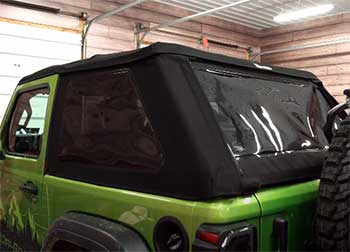When it comes to Jeeps, there’s a longstanding debate among off-roading enthusiasts: sailcloth or twill for the soft top?
While both materials have their own advantages and drawbacks, choosing the right one for your Jeep can make a world of difference in terms of comfort, durability, and style.
In this comprehensive guide, we’ll explore the ins and outs of sailcloth and twill Jeep tops, comparing their pros and cons to help you make an informed decision.
A Brief Comparison Table
| Feature | Sailcloth | Twill |
| Material | Woven polyester | Cotton, polyester, or a blend |
| Durability | High | Moderate to high |
| Weather Resistance | High | Moderate to high |
| Insulation | Moderate | Superior |
| Noise Reduction | Moderate | Enhanced |
| Appearance | Standard, utilitarian | Luxurious, sophisticated |
| Maintenance | Low | Higher |
| Cost | Budget-friendly | More expensive |
| Customization | Available in various colors/styles | Available in various colors/styles |
| Installation | Depends on the specific product | Depends on the specific product |
| Warranty & Support | Varies by manufacturer | Varies by manufacturer |
The Pros of Sailcloth Jeep Tops

- Durability and Weather Resistance
Sailcloth tops are known for their strength and weather resistance. Made from heavy-duty polyester, they can withstand harsh elements like rain, snow, and UV rays.
This is especially important for off-roading enthusiasts who frequently expose their Jeeps to extreme weather conditions.
- Budget-Friendly
Another advantage of sailcloth is its affordability. In general, sailcloth Jeep tops tend to be less expensive than their twill counterparts.
If you’re on a tight budget or simply looking for a cost-effective option, a sailcloth top might be the perfect choice for you.
- Low Maintenance
Sailcloth is relatively low-maintenance, requiring only occasional cleaning to keep it looking its best. This can be a significant advantage for those who don’t have the time or inclination to invest in frequent upkeep.
The Cons of Sailcloth Jeep Tops
- Less Insulation
One downside of sailcloth tops is that they offer less insulation compared to twill. This means that sailcloth might not be the best choice for those living in colder climates or those who often use their Jeep in extreme weather conditions.
- Less Noise Reduction
Another drawback of sailcloth is that it tends to be less effective at reducing road noise compared to twill. If you’re particularly sensitive to noise or planning long road trips, a sailcloth top might not be the most comfortable option.
The Pros of Twill Jeep Tops

- Superior Insulation
One of the most significant advantages of twill Jeep tops is their superior insulation.
The thicker material and tighter weave provide better protection against cold weather, making Twill an ideal choice for those who live in colder climates or frequently venture into the great outdoors.
- Enhanced Noise Reduction
Twill also excels at reducing road noise, thanks to its dense construction. This can make for a more comfortable driving experience, especially during long road trips or when traversing rough terrain.
- Luxurious Feel and Appearance
Twill Jeep tops have a more luxurious feel and appearance compared to sailcloth. The softness and sheen of the fabric can add a touch of sophistication to your Jeep, making it stand out from the crowd.
The Cons of Twill Jeep Tops
- Higher Cost
The main downside of Twill Jeep tops is their higher price point. While the luxurious feel and improved insulation may be worth the investment for some, others might find the cost prohibitive.
- More Maintenance Required
Twill tops tend to require more maintenance compared to sailcloth. The fabric is more susceptible to dirt and stains, which means you’ll need to clean it more frequently to keep it looking its best.
Additionally, twill may be more prone to wear and tear over time, necessitating repairs or replacement sooner than with a sailcloth top.
Additional Considerations For Sailcloth And Twill Jeep Tops
Now that we’ve covered the main pros and cons of sailcloth and twill Jeep tops, let’s delve into some additional factors you might want to consider before making your decision.
- Installation and Compatibility
When choosing a soft top for your Jeep, it’s essential to ensure that it’s compatible with your specific model and that installation is relatively straightforward.
Most sailcloth and twill tops are designed to fit a range of Jeep models, but it’s always a good idea to double-check compatibility before making a purchase.
Additionally, consider the ease of installation. Some soft tops may require professional installation, while others can be installed by the owner with basic tools and a bit of patience. If you’re a DIY enthusiast, you might prefer a soft top that you can install yourself.
- Customization Options
Another factor to consider is customization. Some Jeep owners love to personalize their vehicles, and soft tops can be an excellent opportunity to do so.
Both sailcloth and twill tops are available in a variety of colors and styles, allowing you to choose a look that matches your personality and preferences. Keep in mind, however, that custom options may come at an additional cost.
- Warranty and Support
Lastly, don’t forget to consider the warranty and support offered by the soft top manufacturer. A good warranty can provide peace of mind, knowing that you’re covered in the event of any defects or issues with your soft top.
Additionally, responsive and knowledgeable customer support can be invaluable when dealing with installation or maintenance questions.
Also Read: Differences Between Adams 1310 And 1350 Driveshafts.
Frequently Asked Questions (FAQ)
The choice between sailcloth and twill depends on your specific needs and preferences. Sailcloth tops are more affordable, durable, and low-maintenance, while twill tops offer superior insulation, noise reduction, and a more luxurious appearance. Consider your budget, climate, and how you plan to use your Jeep when making your decision.
Jeep soft tops primarily differ in the materials they’re made from, with sailcloth and twill being the two most popular options. They also vary in terms of insulation, noise reduction, appearance, and cost.
Jeep soft tops can be made from various materials, including sailcloth (woven polyester) and twill (a textile weave made from cotton, polyester, or a blend of both). Each material has its own unique properties, advantages, and disadvantages.
Some drawbacks of having a soft top Jeep include less insulation and noise reduction compared to a hardtop, as well as increased maintenance requirements. Additionally, soft tops may be less secure and more prone to wear and tear than hardtops.
Jeep soft top windows are typically made from clear or tinted vinyl or plastic. Being lightweight, flexible, and weather-resistant, it is suitable for use in a variety of conditions. However, it may be prone to scratching and discoloration over time, so proper care and maintenance are essential.
Final Thoughts
The debate between sailcloth and twill Jeep tops ultimately comes down to personal preference, budget, and the specific needs of your Jeep.
By taking into account the pros and cons of each material, as well as the additional factors discussed above, you can make a well-informed decision that will enhance your off-roading experience for years to come.
Whether you choose the rugged durability of sailcloth or the luxurious comfort of twill, a soft top can transform your Jeep into the ultimate adventure mobile.



